For your first hike, selecting the appropriate attire is essential. Begin with a moisture-wicking base layer to manage sweat, adding an insulating mid-layer and a waterproof outer layer for protection against sudden weather changes. Choose footwear that matches the terrain, ensuring a proper fit to avoid blisters; sturdy boots for rocky paths or trail runners for flatter trails. Complement with durable hiking socks and essential sun and rain protection like wide-brimmed hats, UV-block sunglasses, and lightweight, breathable jackets. Material choices such as merino wool and polyester offer comfort and efficiency. Explore further to optimize your hiking experience.
Key Takeaways
- Pack moisture-wicking base layers, insulating mid-layers, and waterproof outer layers to adapt to changing weather conditions.
- Choose sturdy hiking boots or trail running shoes based on terrain, ensuring a proper fit to prevent blisters.
- Wear durable, moisture-wicking hiking socks to manage sweat and reduce blister risk.
- Use sunscreen, a brimmed hat, and UV-protective sunglasses for effective sun protection.
- Carry a lightweight, waterproof jacket and rain gear to prepare for unexpected weather changes.
Assessing Weather Conditions
Evaluating weather conditions is an essential step in preparing for your first hike, ensuring both safety and comfort throughout the journey. Mastering the art of weather forecasting is vital, as it enables hikers to anticipate changes and adjust their gear accordingly.
Begin by checking the forecast for both the trailhead and your destination. Remember, elevation impact can cause dramatic weather variations; higher altitudes often experience colder temperatures and more unpredictable conditions.
Prepare for sudden weather changes, especially in high-altitude environments. Temperatures can drop rapidly, so pack additional layers to maintain warmth. A reliable system might include a moisture-wicking base layer, insulating mid-layer, and a windproof, waterproof outer layer. This combination allows for quick adjustments to changing conditions, enhancing both comfort and safety.
Rain is always a possibility, regardless of the season or location. A lightweight, waterproof jacket is an essential piece of gear, protecting against unexpected downpours.
Additionally, consider wind conditions; high winds can exacerbate cold temperatures, making a windproof outer layer indispensable.
Choosing the Right Footwear
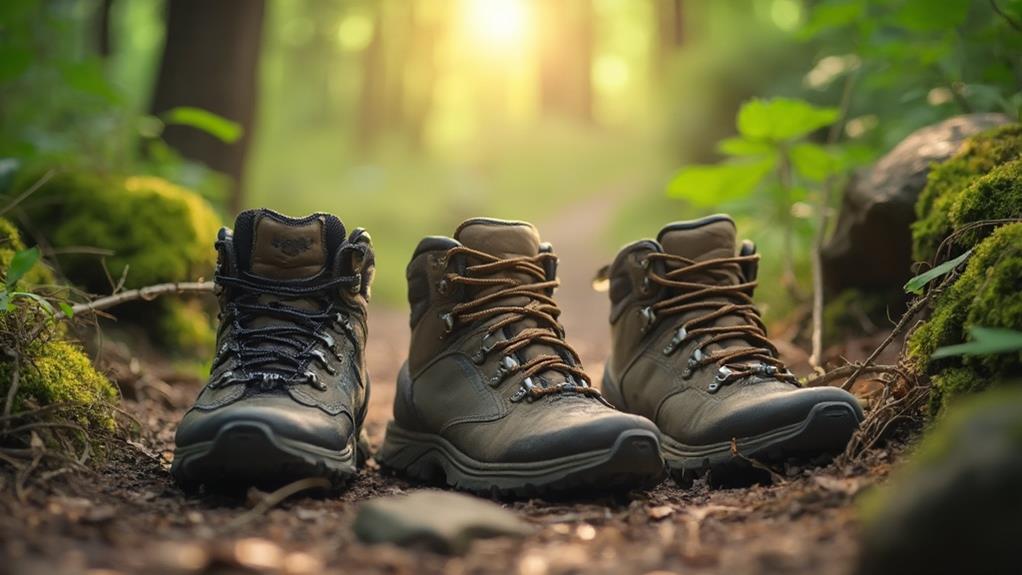
When preparing for your first hike, selecting the appropriate footwear is essential to ensuring both safety and comfort on the trail.
Prioritize a proper fit by allowing ample space in the toe box to avoid blisters, and choose footwear constructed from materials that suit the expected weather conditions, such as waterproof options for wet terrains.
Additionally, matching the shoe type to the terrain—whether opting for rugged boots on challenging paths or lightweight trail runners for less demanding trails—will enhance your hiking experience considerably.
Selecting Proper Fit
Selecting the right footwear for your inaugural hike is an essential step that can greatly impact your experience on the trail. Proper fit is paramount, as it dictates comfort and functionality. Modern footwear innovations have led to designs that prioritize both safety and comfort.
When fitting hiking boots, verify there is a thumb's width of space between your longest toe and the end of the shoe. This small allowance prevents discomfort during descents, a common challenge for hikers.
For those tackling rocky or uneven terrain, sturdy hiking boots are recommended for maximum support and protection. Conversely, trail running shoes offer lightweight comfort suited for well-maintained paths. Whichever choice you make, achieving a snug fit around the heel is vital to prevent slippage that can result in blisters.
Simultaneously, allow ample room in the toe box to facilitate natural foot movement. Try on footwear with the socks intended for hiking, especially those that are moisture-wicking and thicker, to confirm compatibility.
Before starting a hike, break in your boots by wearing them on short walks. This practice not only aids in detecting pressure points but also contributes to effective hiking boot maintenance.
Material and Terrain Match
In the domain of hiking gear, choosing the appropriate footwear material is essential for aligning with the terrain you'll encounter. The durability of your footwear and the traction features it offers are significant for both safety and comfort.
To optimize your hiking experience, consider the following:
1. Terrain Analysis: For rocky or uneven paths, opt for sturdy hiking boots that provide maximum protection and support. Their robust construction enhances footwear durability, important for challenging terrains.
For well-maintained trails, lightweight trail running shoes offer sufficient comfort.
2. Waterproofing: In wet conditions, select footwear with waterproof materials such as GORE-TEX. This feature is crucial to keep feet dry and blister-free during hikes, especially in areas with unpredictable weather.
3. Traction Features: Opt for shoes with outsoles that have deep lugs to guarantee a strong grip on slippery or loose surfaces. This is particularly important for steep or muddy trails where traction is essential for preventing slips.
4. Support Requirements: Consider the level of support necessary. Mid-cut boots provide additional ankle support for heavier loads or rough terrains, enhancing stability.
Low-cut shoes are more suitable for lighter day hikes, offering flexibility without compromising comfort.
Layering Basics
How can you guarantee comfort and efficiency on your first hike? Employing effective layering strategies is key to achieving ideal temperature regulation and moisture management in varying conditions.
The layering system comprises three essential components: the base, mid, and outer layers, each serving a vital function.
The base layer is your first defense against moisture, crafted from moisture-wicking materials like merino wool or synthetic fabrics. These materials efficiently draw sweat away from your skin, maintaining dryness and preventing the chilling effect of wet clothing.
Select a snug fit to enhance moisture management effectiveness.
Next, the mid-layer provides necessary insulation, important for maintaining warmth during cooler temperatures. Opt for a fleece or lightweight jacket, which offers warmth without excessive bulk, allowing for flexibility and ease of movement.
This layer should be easily adjustable to accommodate changes in activity level and ambient temperature.
Selecting Hiking Socks
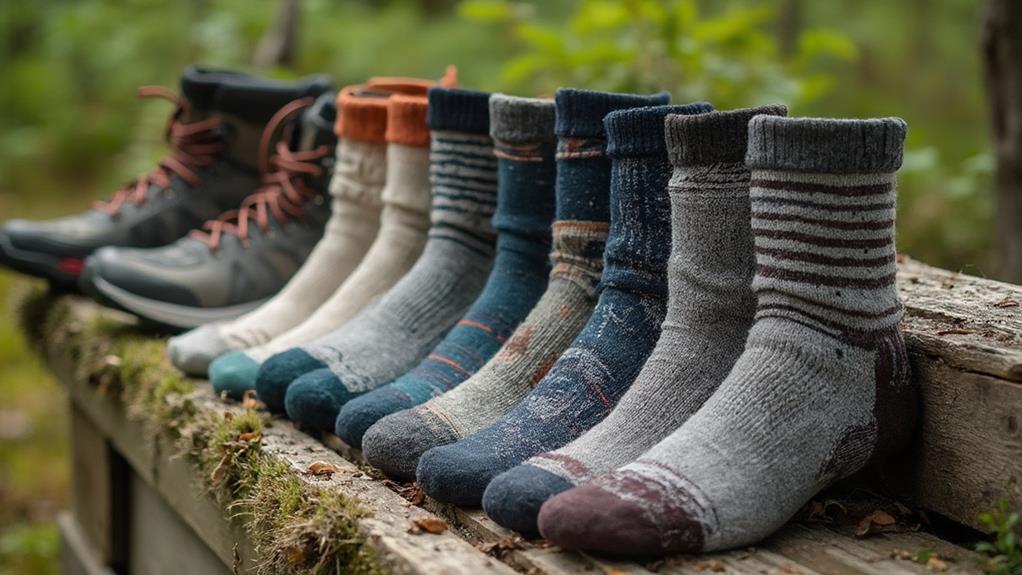
While mastering the art of layering forms the foundation of hiking comfort, choosing the right hiking socks is equally important for ensuring a pleasant experience on the trail. Proper hiking socks considerably contribute to blister prevention and overall foot comfort.
The durability of your socks is vital, and materials like wool and quick-drying synthetics excel in this regard. These materials also offer superior moisture management, efficiently wicking sweat away from your skin to keep your feet dry and reduce the risk of blisters.
Consider the following essential factors when selecting hiking socks:
- Height and Fit: Taller socks can prevent chafing and should fit snugly without being too tight, ensuring they stay in place during your hike.
- Liner Socks: For those prone to blisters, liner socks provide an additional layer of protection, minimizing friction between your foot and the shoe.
- Compression Socks: Ideal for trail runners and long-distance hikers, these socks enhance blood flow and reduce fatigue, supporting endurance.
- Weather and Terrain Adaptability: Assess the conditions of your hike. Opt for waterproof socks in wet environments, and choose thicker options for warmth in colder climates.
Sun and Rain Protection
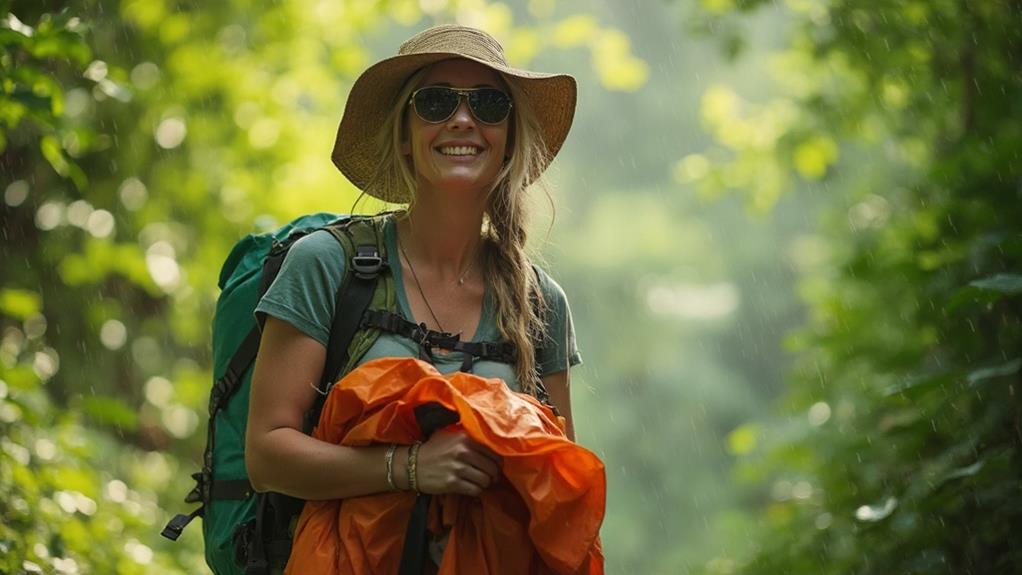
When preparing for your first hike, effective sun and rain protection is paramount to guarantee comfort and safety.
Sunscreen should be applied generously, with reapplication every two hours, especially at higher elevations where UV exposure is intensified.
Additionally, investing in a quality rain jacket or waterproof poncho, alongside UV protection accessories like a brimmed hat and sunglasses, will provide essential coverage against the elements.
Essential Sun Protection Tips
Guaranteeing ideal sun protection during a hike is paramount to both comfort and safety. The combination of sunscreen application and strategic clothing choices plays a critical role in effective sunburn prevention. Here is a list of essential tips to keep in mind:
- Sunscreen Application: Choose a broad-spectrum sunscreen with at least SPF 30. Apply it generously to all exposed skin, especially at high elevations where UV exposure is more intense. Reapply every two hours to maintain protection throughout your hike.
- Protective Headwear: Utilize a wide-brimmed hat to provide significant shade for your face, neck, and ears. This not only prevents sunburn but also helps regulate temperature. Complement your hat with sunglasses that offer UV protection to safeguard your eyes from harmful rays.
- Appropriate Clothing: Opt for long-sleeve shirts and sun hoodies made from lightweight, breathable, and moisture-wicking fabrics. These materials allow airflow while shielding your skin from direct sunlight. Consider UV-blocking long pants to enhance coverage.
- Additional Gear: Always have a lightweight, breathable rain jacket in your pack. While primarily for rain, it can serve as an extra layer of sun protection if needed.
These tips guarantee a safer, more comfortable hiking experience.
Choosing Rain Gear
Selecting the right rain gear can make the difference between a miserable and an enjoyable hike, especially when weather conditions are unpredictable. A well-chosen rain jacket is indispensable, offering protection against unexpected precipitation. Look for rain jacket features such as adjustable hoods and pit zips, which provide essential ventilation to prevent overheating. Lightweight and breathable designs are critical to maintaining comfort on the trail.
| Gear Type | Key Features/Benefits |
|---|---|
| Rain Jacket | Adjustable hoods, pit zips, breathable |
| Waterproof Pants | Breathability, moisture resistance |
| Poncho | Backpack coverage, affordable, movement-friendly |
Waterproof pants complement your rain jacket, ensuring thorough protection. These pants should offer breathability to maintain airflow and prevent discomfort during strenuous hikes. Ponchos present an affordable alternative, valued for their versatility and the ability to shield both hiker and backpack. The poncho benefits include ease of movement and substantial coverage, though they may lack the tailored fit of a jacket and pants combination.
Incorporating these rain gear options into your hiking kit will prepare you for unexpected weather changes. By prioritizing practical features and considering affordable alternatives, you can enhance your hiking experience while staying protected against the elements.
UV Protection Accessories
Effective UV protection is essential for hikers, especially in high-elevation areas where sun exposure is more intense.
Implementing UV protection strategies is important to prevent hiking sunburn and guarantee comfort on the trail. Below are necessary UV protection accessories to take into account for your next hike:
1. Sunscreen: An indispensable part of any hiker's gear, sunscreen provides a primary defense against harmful UV rays.
Select a broad-spectrum product with at least SPF 30, and remember to reapply every two hours, especially at higher altitudes where UV exposure intensifies.
2. Brimmed Hats: A wide-brimmed hat is a practical solution to shield your face and neck from direct sunlight, reducing the risk of hiking sunburn.
Opt for hats made from lightweight, breathable materials to enhance comfort during prolonged hikes.
3. Sunglasses with UV Protection: Protecting your eyes is just as important as safeguarding your skin.
Sunglasses equipped with UV protection lenses can prevent eye strain and damage caused by bright sunlight, making them an important addition to your hiking gear.
4. Long-Sleeve Shirts: Choose shirts made from lightweight, breathable fabrics with moisture-wicking properties.
These not only provide coverage against UV rays but also enhance comfort by managing sweat and heat during your hike.
Understanding Material Options

Steering through the myriad of material options for hiking attire is akin to decoding an intricate puzzle, where each piece plays a significant role in enhancing comfort and performance.
When examining fabric comparisons, it's important to take into account moisture management among other factors. Nylon is renowned for its durability and decent moisture-wicking properties, yet it absorbs water and dries slowly, which may present challenges in wet conditions. Conversely, polyester stands out for its ability to wick moisture efficiently and dry swiftly, although it can retain odors during extended use—a factor worth taking into account for multi-day hikes.
Wool, specifically merino, excels in providing insulation and breathability, offering warmth even when damp. Its downside, however, lies in its lower durability and slower drying time compared to synthetic counterparts. Polypropylene is notable for its heat-trapping capabilities, often used in blends, making it suitable for cold-weather base layers despite its lesser breathability.
When selecting materials, assess your hiking environment and personal comfort preferences. Balancing warmth, moisture management, and drying time is key to optimizing your hiking experience.
Each material offers distinct advantages, ensuring you remain comfortable and prepared for varied trail conditions.
Essential Accessories

Once the appropriate materials for your hiking attire have been chosen, attention must turn to the accessories that will enhance your hiking experience and guarantee your safety on the trail.
Essential hiking gear not only complements your outfit but also serves as crucial trail essentials. Here is a focused list of must-have accessories for your first hike:
- Sunglasses: A good pair of sunglasses is indispensable for protecting your eyes from harmful UV rays and windborne debris. Opt for polarized lenses to reduce glare and enhance visibility on sunny trails.
- Wide-Brimmed Hat or Cap: This accessory serves as a shield against intense sun exposure, reducing the risk of heat-related issues and sunburn. Choose a hat with a wide brim for maximum coverage of your face and neck.
- Lightweight Rain Jacket or Poncho: Weather on the trail can be unpredictable. A packable rain jacket or poncho guarantees you remain protected from unexpected rain and wind, maintaining comfort and safety.
- First Aid Kit: Critical for addressing minor injuries, a first aid kit should include essentials like band-aids, antiseptic wipes, pain relief, and blister treatment.
This small but crucial piece of hiking gear can make a significant difference in emergency situations.
Packing Day Hike Essentials
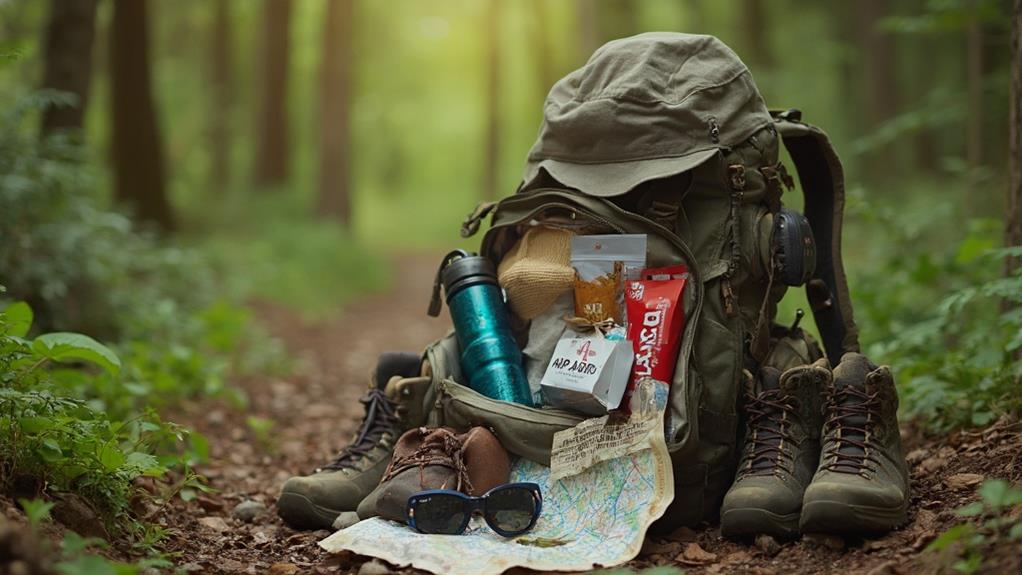
When preparing for a day hike, meticulous packing of essentials is essential to guaranteeing a safe and enjoyable experience. Foremost, hydration strategies should be prioritized, with a general guideline of carrying half a liter of water per hour of hiking. This guarantees adequate fluid intake to maintain peak performance and prevent dehydration. Consider using a hydration reservoir or water bottles for convenient access and monitoring of your consumption.
Alongside hydration, selecting appropriate snack options is significant. Nutritious snacks such as trail mix or energy bars provide quick energy and help maintain stable energy levels throughout your trek. These snacks are lightweight, non-perishable, and pack easily, making them ideal for day hikes.
A well-equipped first aid kit is another indispensable item, containing essentials like band-aids, antiseptic wipes, and pain relief medication for minor injuries.
Proper clothing layering is also important, with a focus on weather adaptability. Include an extra insulating layer and a waterproof jacket to be prepared for sudden weather changes.
Utilize your rucksack's compartments for organized packing, guaranteeing frequently accessed items such as snacks and maps are readily accessible. This strategic organization enhances efficiency, allowing you to focus on the hiking experience with ease and confidence.
Safety and Emergency Gear
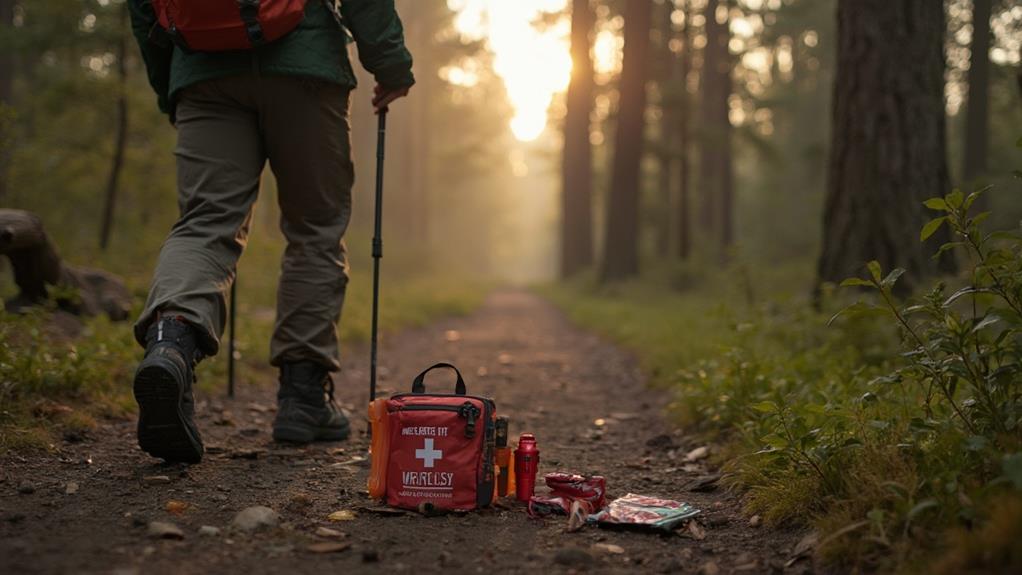
In addition to packing essentials, equipping yourself with safety and emergency gear is fundamental for a secure hiking experience. Proper preparation can mitigate risks and guarantee that you are ready to handle unexpected situations on the trail.
The following items are indispensable components of your hiking kit:
- Emergency Blanket: A compact emergency blanket is essential for retaining body heat in sudden cold weather or emergencies. Its ability to reflect up to 90% of body heat can prevent hypothermia and provide warmth when needed most.
- Whistle: This simple yet effective tool can greatly increase your chances of being rescued. Unlike a voice, a whistle can be heard from far distances, making it an indispensable safety item.
- Headlamp or Flashlight: Confirm you have a headlamp or flashlight with reliable battery life to maintain visibility during low-light conditions. This not only prevents accidents on the trail but also aids in navigation.
- Personal Locator Beacon (PLB): Essential for remote hikes, a PLB can transmit distress signals to rescuers. This device acts as a key lifeline in emergencies, providing precise location data to expedite rescue efforts.
Equipping yourself with these items enhances safety and preparedness on any hike.
Frequently Asked Questions
What Is the Dress Code for Hiking?
The hiking dress code prioritizes moisture-wicking layers, robust hiking footwear, and adaptability to weather considerations. Essential gear includes synthetic or wool clothing, protective outerwear, and accessories for sun protection, ensuring comfort and safety across various terrains and conditions.
What Clothing Do I Need for Hiking?
Selecting appropriate clothing for hiking involves considering weather conditions and choosing suitable hiking footwear. Opt for moisture-wicking base layers, insulating mid-layers, and a waterproof outer layer. Guarantee sturdy footwear and accessories like hats and gloves for protection.
What Do You Need for Your First Hike?
For your first hike, prioritize hiking essentials: moisture-wicking layers, sturdy footwear, and a waterproof jacket. First hike tips include packing sun protection like hats and sunglasses. Choose gear that suits the terrain for comfort and safety.
What Should I Bring on a First Date Hike?
For a successful hiking date, bring essentials such as ample water, energy snacks, and a first aid kit. Romantic trail tips include packing a lightweight picnic blanket and ensuring reliable navigation tools for a seamless, enjoyable experience together.
Conclusion
In conclusion, proper preparation for a first hiking excursion requires careful consideration of weather conditions, appropriate footwear, and effective layering techniques. Selecting high-quality hiking socks and understanding material options are vital for comfort and performance. Incorporating sun and rain protection, along with essential accessories, enhances preparedness. Packing necessary day hike essentials, coupled with safety and emergency gear, guarantees a secure and enjoyable experience. Adhering to these guidelines promotes a successful and safe introduction to hiking activities.